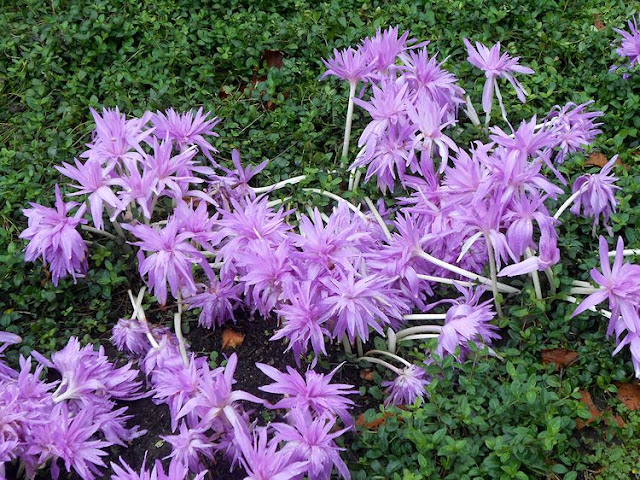The entrance to the Chicago Botanic Gardens is flanked by two large beds
of "Orange Zest Chrysanthemums." All of the flowers growing in the Garden are
hardy for the Chicago climate, so if you like something, you can make a note and
get it for your own garden.
The main building has a large portico with a number of very large pots filled with
bright "Yellow Quill" mums. This pot may have a dozen plants growing in it.
The entrance to the gardens is across a bridge, which for autumn is hung with
blankets of purple "Cascade Chrysanthemums." These are trained to drape and hang
by tying fishing weights to the tips of stems as they grow and bending them
gradually downward.
by tying fishing weights to the tips of stems as they grow and bending them
gradually downward.
Your first look at the gardens is across the Esplanade, which has eight large beds
of massed chrysanthemums, which will bloom for a month. The lighter orange mums
are "Olivia" and the darker ones are "Miranda."
Here is a large bed of "Olivia Mums." Each mound is one pot.
These are the "Miranda Mums," glowing in a rich orange color for autumn.
From the Esplanade, you climb a few stairs to the Heritage Garden, where you can
find plants from Asia, Africa, and South America. This is a Lemon-Yellow Sunflower
from South America.
These are "Guernsey Lilies," which are from Africa. They are
brilliant in color and are members of the amaryllis family.
"Guernsey Lilies" in a pot.
"Raspberry / Vanilla" panicula hydrangeas. There were many types of hydrangeas
all over the gardens. The paniculas are characterized by their large cluster-heads.
In the center of the Heritage Garden is a large terrace with giant pots of mums in
"Indian Summer" chrysanthemums.
These are the darker "Glowing Embers" chrysanthemums.
The Regenstein Building is in the center of the Garden and includes four
tropical greenhouses, the library, special exhibition halls, the bonsai tree
collection, and other rooms. In the center is a large reflecting pool which is
always specially decorated. Right now it has brilliant Pelee Mums in red and
yellow, as well as the dark colors of coleus and other foliage.
Pelee Mums are highly prized for their short stems, large flowers, and
brilliant colors.
The Heritage Garden also includes three large water lily ponds, and today there
were many flowering plants in a variety of colors. Most bloom for only one day.
The plants must be taken inside and protected from the Chicago winter, so they
are planted in large tubs which can be moved back and forth.
Purple Water Lily
Pink Water Lily and variegated floating pod.
Pale Blue Water Lilies
Pink, peach, and yellow hybrid water lily.
A pot of "Outrageous Orange" chrysanthemums in front of the Regenstein Bldg.
A large pot of "Gigi Mums." In back are "Harvest Bronze" mums.
Japanese Anemones, usually in white, were growing in several parts of the Garden.
In the Vegetable Garden was a "Vertical Wall Garden." Visitors are
encouraged to have gardens even if their space at home is limited. This is a
wooden frame about five inches wide attached to a wall. Inside is a "bag" of
black plastic, filled with soil and supported by cross bars of wood. You punch
holes in the plastic and insert plants and punch holes in the top and allow water
to drain through. This Wall Garden is filled with eight types of lettuce, but
there are other wall gardens with flowers of many kinds. It takes up little space.
A bed of "Purple Amphion" mums.
"Gold Rush" black-eyed susans.
"Klamath Falls" yellow mums; the ywllow color is particularly intense.
"White Autumn Crocus" were growing in the Bulb Garden. Crocus are spring
flowers, but these put up their leaves in the spring, but no flowers. The leaves gradually
die down and nothing is seen. Then in late September, these beautiful flowers,
without leaves, appear in masses.
Lavender Autumn Crocus. This is the more common variety. We saw them when they
were first planted; there were just a couple each in several places. Over the years,
they multiply and double each year. Now there are large masses of them all along the
walk in the Bulb Garden.
__






























Nice photos. I haven't been to the botanical garden in Chicago since I was 12 years old. Thanks for sharing. Philip Colpitts
ReplyDeleteThanks John!
ReplyDelete